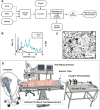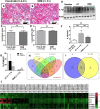Colonic oxygen microbubbles augment systemic oxygenation and CO2 removal in a porcine smoke inhalation model of severe hypoxia
- PMID: 37357222
- PMCID: PMC10290975
- DOI: 10.1186/s40635-023-00517-3
Colonic oxygen microbubbles augment systemic oxygenation and CO2 removal in a porcine smoke inhalation model of severe hypoxia
Abstract
Inhalation injury can lead to pulmonary complications resulting in the development of respiratory distress and severe hypoxia. Respiratory distress is one of the major causes of death in critically ill patients with a reported mortality rate of up to 45%. The present study focuses on the effect of oxygen microbubble (OMB) infusion via the colon in a porcine model of smoke inhalation-induced lung injury. Juvenile female Duroc pigs (n = 6 colonic OMB, n = 6 no treatment) ranging from 39 to 51 kg in weight were exposed to smoke under general anesthesia for 2 h. Animals developed severe hypoxia 48 h after smoke inhalation as reflected by reduction in SpO2 to 66.3 ± 13.1% and PaO2 to 45.3 ± 7.6 mmHg, as well as bilateral diffuse infiltrates demonstrated on chest X-ray. Colonic OMB infusion (75-100 mL/kg dose) resulted in significant improvements in systemic oxygenation as demonstrated by an increase in PaO2 of 13.2 ± 4.7 mmHg and SpO2 of 15.2 ± 10.0% out to 2.5 h, compared to no-treatment control animals that experienced a decline in PaO2 of 8.2 ± 7.9 mmHg and SpO2 of 12.9 ± 18.7% over the same timeframe. Likewise, colonic OMB decreased PaCO2 and PmvCO2 by 19.7 ± 7.6 mmHg and 7.6 ± 6.7 mmHg, respectively, compared to controls that experienced increases in PaCO2 and PmvCO2 of 17.9 ± 11.7 mmHg and 18.3 ± 11.2 mmHg. We conclude that colonic delivery of OMB therapy has potential to treat patients experiencing severe hypoxemic respiratory failure.
© 2023. The Author(s).
Conflict of interest statement
Authors PAM, RMS, RTS, MAB, and KLB have financial holdings in the company Respirogen, Inc. in the form of stock and stock option agreements. MAB is a Founder and Chief Scientific Officer of Respirogen, Inc. Respirogen, Inc. looks to commercialize the oxygen microbubble technology.
Figures






References
-
- CDC (2020) COVID data tracker. Centers for Disease Control and Prevention. https://covid.cdc.gov/covid-data-tracker
Grants and funding
LinkOut - more resources
Full Text Sources

